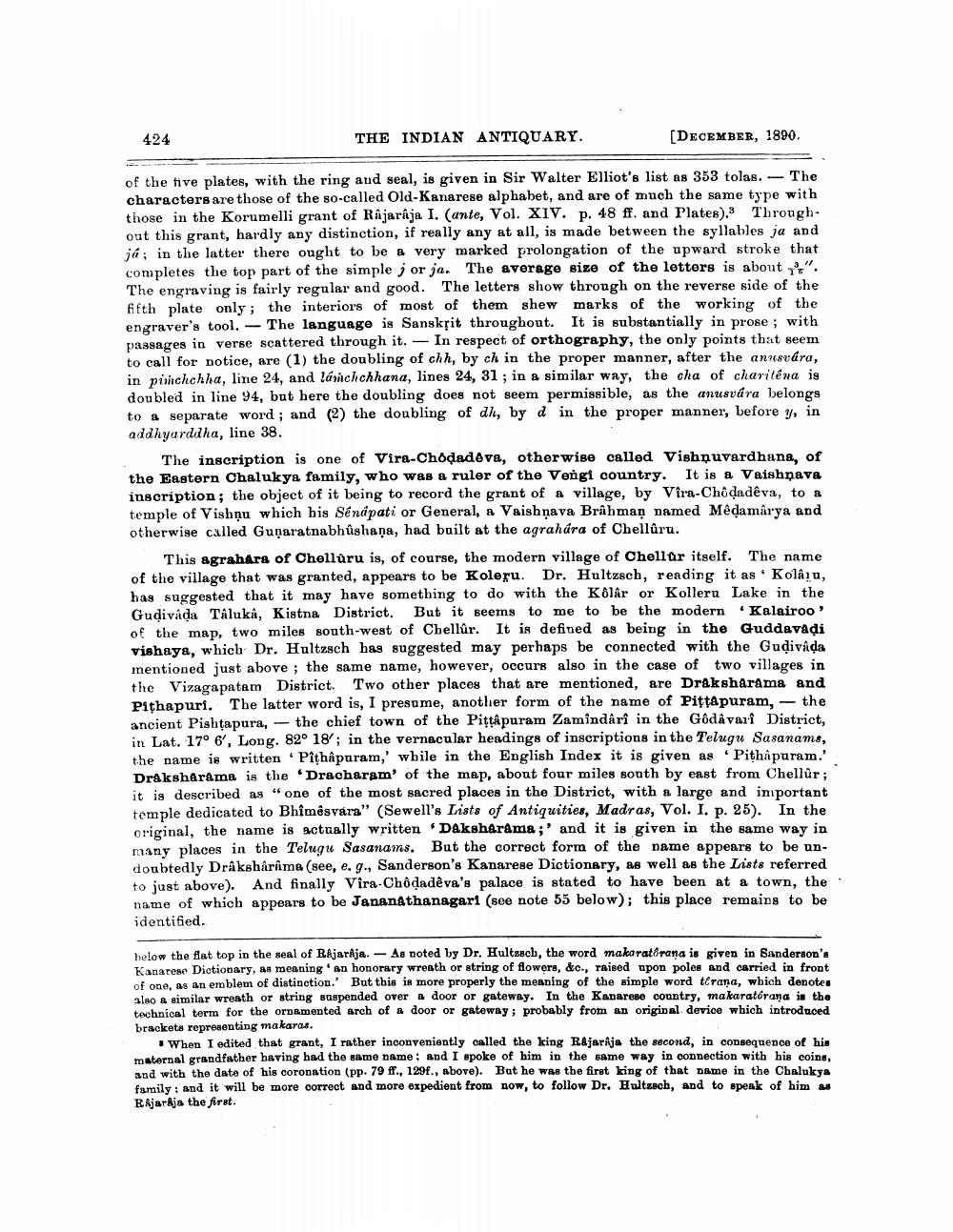________________
424
THE INDIAN ANTIQUARY.
[DECEMBER, 1890.
of the five plates, with the ring and seal, is given in Sir Walter Elliot's list as 353 tolas. - The characters are those of the so-called Old-Kanarese alphabet, and are of much the same type with those in the Korumelli grant of Rajaraja I. (ante, Vol. XIV. p. 48 ff. and Plates). Throughout this grant, hardly any distinction, if really any at all, is made between the syllables ja and já; in the latter there ought to be a very marked prolongation of the upward stroke that completes the top part of the simple j or ja. The average size of the letters is about ". The engraving is fairly regular and good. The letters show through on the reverse side of the fifth plate only; the interiors of most of them shew marks of the working of the engraver's tool. - The language is Sanskrit throughout. It is substantially in prose; with passages in verse scattered through it. - In respect of orthography, the only points that seem to call for notice, are (1) the doubling of chh, by ch in the proper manner, after the anusvára, in puichchha, line 24, and larichchhana, lines 24, 31 ; in a similar way, the cha of chariténa is doubled in line 94, but here the doubling does not seem permissible, as the anusvára belongs to a separate word ; and (2) the doubling of dh, by d in the proper manner, before y, in addhyarddha, line 38.
The inscription is one of Vira-Chodadova, otherwise called Vishnuvardhana, of the Eastern Chalukya family, who was a ruler of the Vengi country. It is a Vaishnava inscription; the object of it being to record the grant of a village, by Vira-Chôdadêva, to a temple of Vishnu which his Sénápati or General, a Vaishnava Brâhman named Médamarya and otherwise called Gunaratnabhushana, had built at the agrahára of Chellûru.
This agrahara of Chellûru is, of course, the modern village of Chellur itself. The name of the village that was granted, appears to be Koleru. Dr. Hultzsch, reading it as . Kolain, has suggested that it may have something to do with the Kolár or Kolleru Lake in the Gudivada Taluka, Kistna District. But it seems to me to be the modern Kalairoo of the map, two miles south-west of Chellûr. It is defined as being in the Guddavadi vishaya, whicb Dr. Hultzsch has suggested may perhaps be connected with the Gudivada mentioned just above ; the same name, however, occurs also in the case of two villages in the Vizagapatam District. Two other places that are mentioned, are Draksharama and Pithapuri. The latter word is, I presume, another form of the name of Pittapuram, - the ancient Pishtapura, - the chief town of the Pittậpuram Zamîndârî in the Godavari District, in Lat. 17° 6', Long. 82° 18'; in the vernacular headings of inscriptions in the Telugu Sasanams, the name is written Pithapuram,' while in the English Index it is given as Pithapuram.' Draksharama is the Dracharam' of the map, about four miles south by east from Chellûr; it is described as “one of the most sacred places in the District, with a large and important temple dedicated to Bhîmêsvara" (Sewell's Lists of Antiquities, Madras, Vol. I. p. 25). In the original, the name is actually written Daksharama ;' and it is given in the same way in many places in the Telugu Sasanans. But the correct form of the name appears to be undoubtedly Drákshârîma (see, e. g., Sanderson's Kanarese Dictionary, as well as the Lists referred to just above). And finally Vira-Chôdadêva's palace is stated to have been at a town, the name of which appears to be Jananathanagari (see note 55 below); this place remains to be identified.
below the flat top in the seal of Rajaraja. - As noted by Dr. Hultsach, the word makaratirana is given in Sanderson's Kanarese Dictionary, as meaning an honorary wreath or string of flowers, &c., raised upon poles and carried in front of one, ws an emblem of distinction. But this is more properly the meaning of the simple word trana, which denotes also a similar wreath or string suspended over a door or gateway. In the Kanarese country, makaratórana is the technical term for the ornamented arch of a door or gateway; probably from an original device which introduced brackets representing makaras.
• When I edited that grant, I rather inconveniently called the king Rajaraja the second, in consequence of his maternal grandfather having had the same name: and I spoke of him in the same way in connection with his coins. and with the date of his coronation (pp. 79 ff., 1298., above). But he was the first king of that name in the Chalukya family: and it will be more correct and more expedient from now, to follow Dr. Hultch, and to speak of him as Rajaraja the first.




